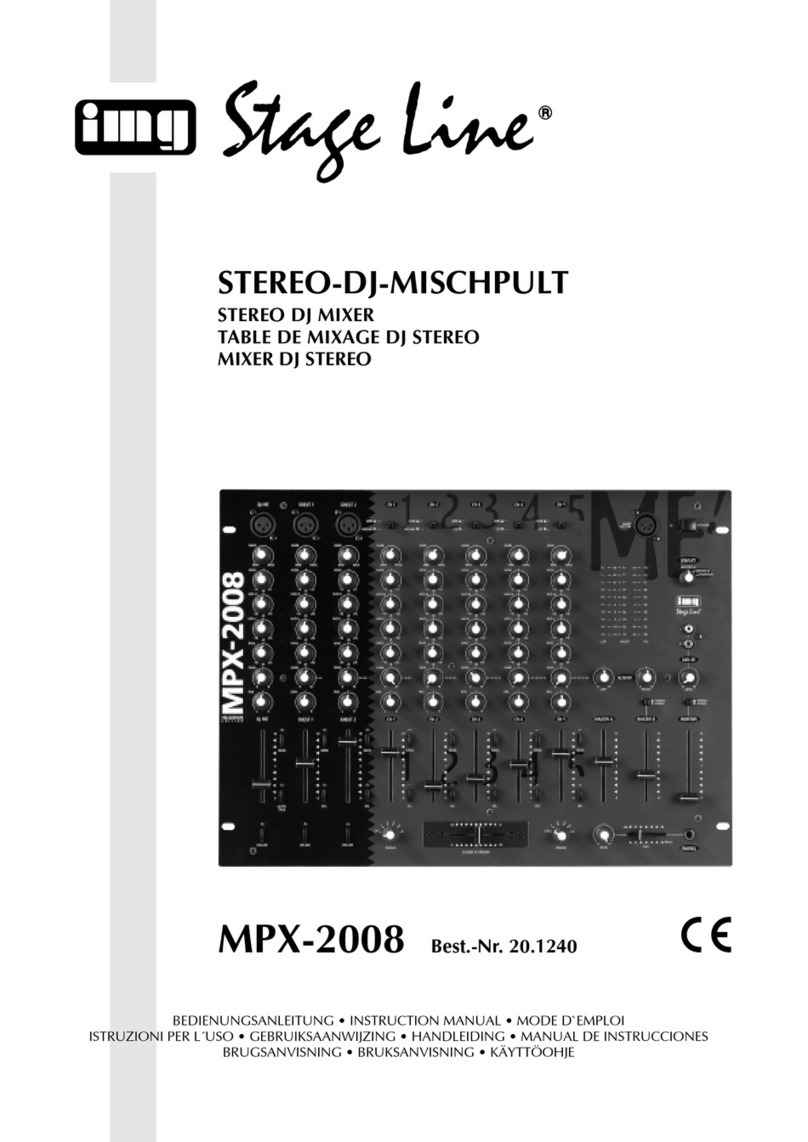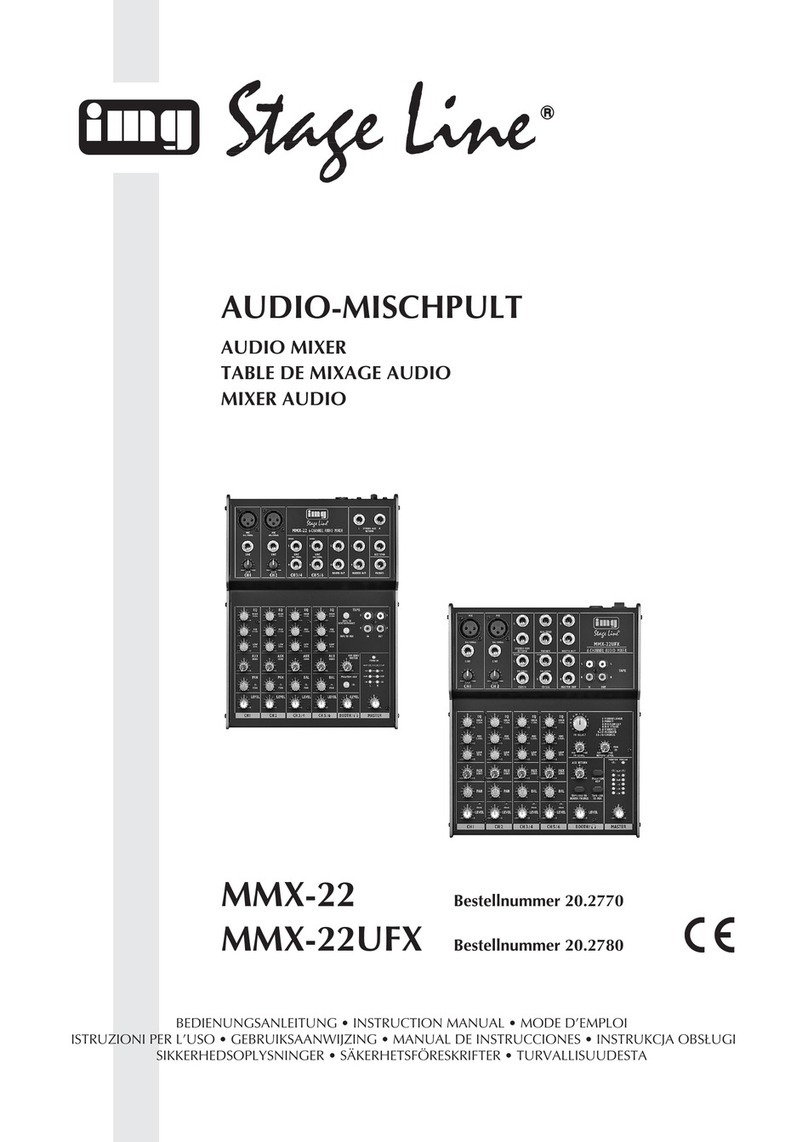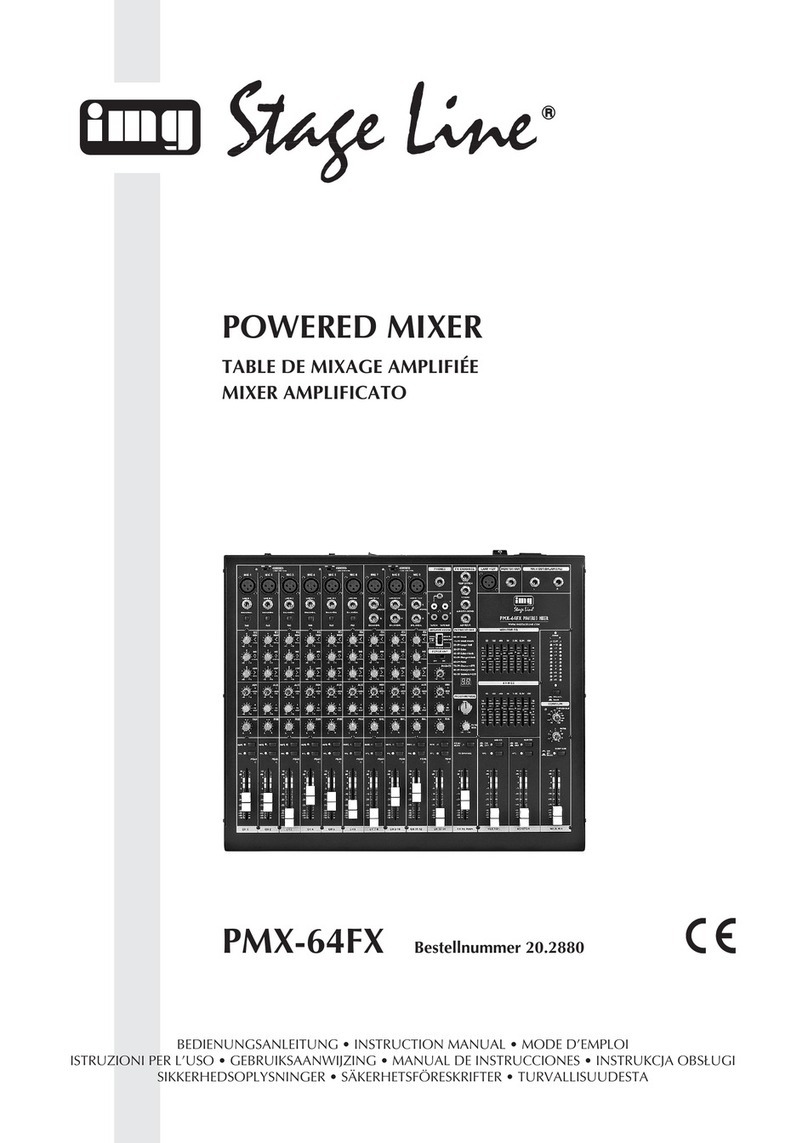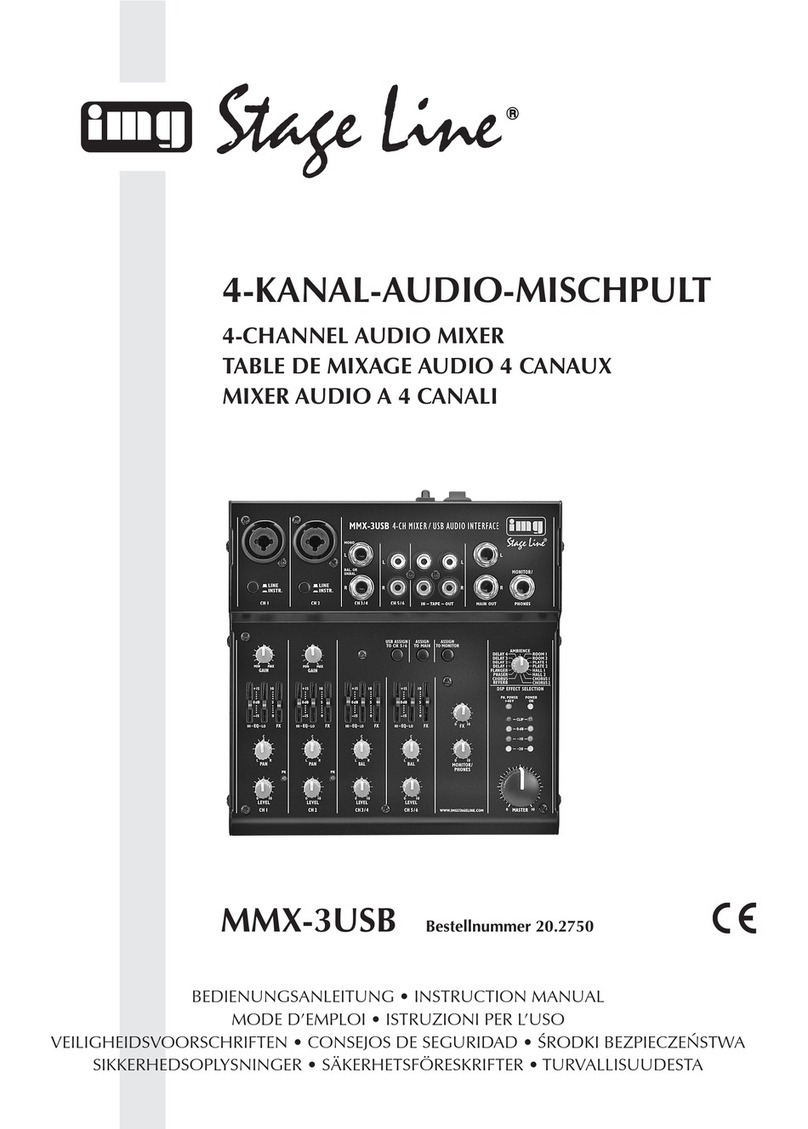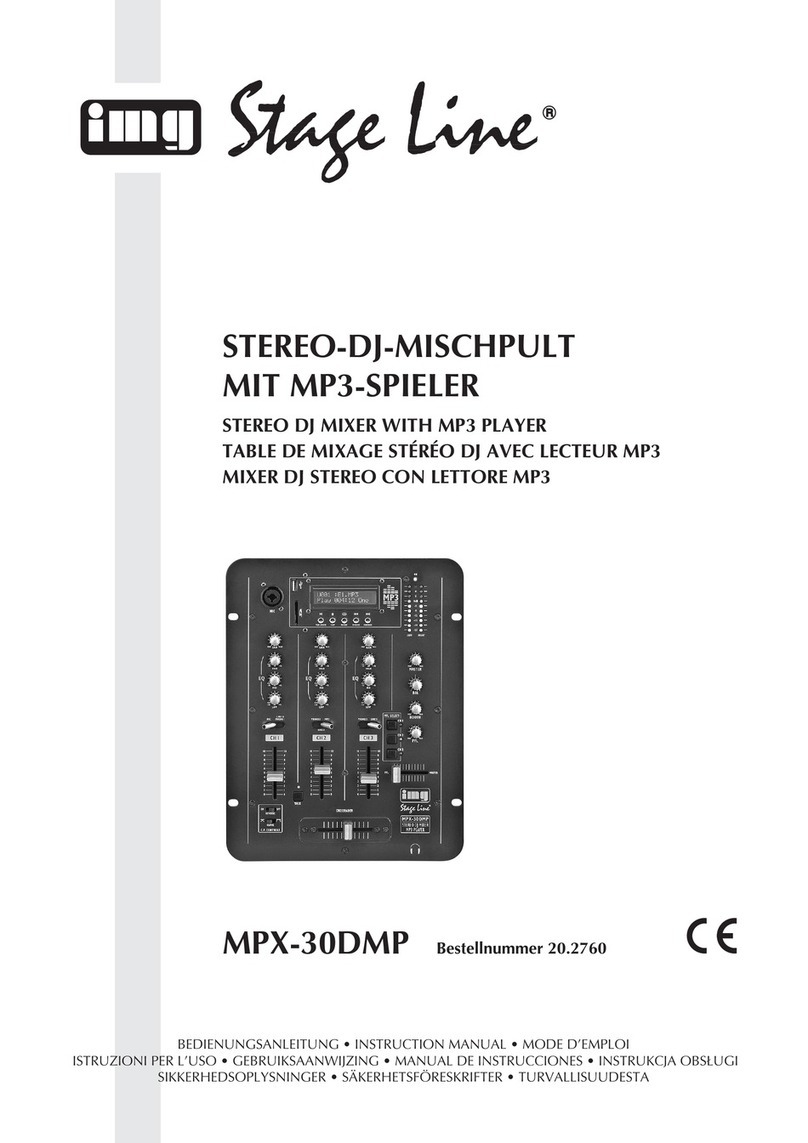6.1 Mode de fonctionnement Mixeur (schéma 4)
Avec ce mode de fonctionnement, un canal stéréo
et six canaux mono au plus peuvent être mixés sur
un canal de sortie stéréo.
1) Enclenchez la touche de commutation MIX/
SPLIT (7) pour le canal correspondant et enclen-
chez la touche de commutation MIXER ON (8).
2) Tournez le réglage LEVEL STEREO OUT (9) jus-
qu’à ce que le rapport de mixage des sources
reliées soit réglé de manière optimale.
3) Avec les touches de commutation LINE/MIC (4),
réglez les canaux mono CH1–CH6 sur les sour-
ces reliées. Si un microphone est connecté,
enclenchez la touche de commutation et désen-
clenchez-la pour des appareils avec niveau ligne.
4) Avec les potentiomètres de réglage LEVEL STE-
REO IN (3) et les réglages de canaux CH1–CH6
(5), réglez le rapport de volume souhaité : réglez
les sources audio qui doivent être le plus fort de
sorte que la LED correspondante (1) brille briève-
ment en rouge pour un passage de musique
avec le volume le plus élevé.
5) Placez le signal de canal mono comme souhaité
dans la base stéréo avec les réglages PAN (6)
des canaux mono CH1–CH6.
6) Avec le réglage LEVEL STEREO OUT(9), réglez
le niveau définitif du signal master stéréo.
6.2 Mode de fonctionnement Répartiteur
(schéma 5)
Avec le mode de fonctionnement Répartiteur, un
signal stéréo peut être réparti sur six canaux mono
et un canal stéréo. Dans le cas de canaux mono, les
parts de signal du signal stéréo peuvent être réglées
séparément avec les réglages PAN. Pour un canal
de sortie stéréo, aucune attribution libre n’est possi-
ble, le signal d’entrée gauche est attribué au signal
de sortie gauche et le signal d’entrée droit est attri-
bué au signal de sortie droit.
1) Désenclenchez la touche de commutation MIX/
SPLIT (7) pour le canal correspondant.
2) Avec les réglages INPUT LEVEL (3), réglez le
niveau d’entrée du signal stéréo de telle sorte
que les LEDs (1) brillent brièvement en rouge
pour les passages de musique les plus forts.
3) Pour les six canaux mono, réglez la part voulue
du signal stéréo avec les réglages PAN (6).
4) Avec les réglages LEVEL CH1–CH6 (5), réglez
individuellement les niveaux des canaux mono.
5) Avec les réglages LEVEL STEREO OUT (9),
réglez le niveau du signal de sortie stéréo.
6.3 Mode de fonctionnement amplificateur
8canaux (schéma 6)
Avec ce mode de fonctionnement, les canaux fonc-
tionnent comme amplificateurs indépendants déli-
vrant un signal de sortie symétrique basse impé-
dance. Les niveaux des six canaux mono et du canal
stéréo peuvent être adaptés séparément. L’adapta-
tion de niveau est par exemple nécessaire si le
niveau de sortie d’une source de signal est trop faible
pour contrôler un appareil placé après. Avec ce
mode de fonctionnement, l’appareil peut également
être utilisé comme préamplificateur micro 6 voies.
1) Enclenchez la touche de commutation MIX/SPLIT
(7) pour le canal correspondant et desenclenchez
la touche de commutation MIXER ON (8).
2) Avec les touches de commutation LINE/MIC (4),
réglez les canaux mono CH1–CH6 sur les sour-
ces reliées. Si un microphone est relié, enclen-
chez la touche de commutation et pour des
appareils à niveau ligne, désenclenchez-la.
3) Pour des canaux mono, réglez le volume sou-
haité avec les réglages LEVEL CH1–CH6 (5).
4) Pour un canal stéréo, réglez le réglage LEVEL
STEREO OUT (9) sur le maximum.
5) Avec les réglages LEVEL STEREO IN (3), réglez
individuellement le niveau souhaité pour le canal
droit et le canal gauche.
6.4 Modes de fonctionnement combinés
Si en mode répartiteur, les six canaux mono ne sont
pas utilisés comme sorties, les canaux restants peu-
vent fonctionner comme amplificateurs distincts in-
dépendants. Voir chapitre 6.3.
7Caractéristiques techniques
Entrées
(Sensibilité d’entrée pour niveau de sortie 1V,
impédance d’entrée)
STEREO IN : . . . . . . . . . 250mV, 30kΩ,
XLR, symétrique
CH1–CH6 : . . . . . . . . . . Ligne 100mV, 40kΩ
commutable sur
Mic 1mV, 6,6kΩ
XLR, symétrique
Alimentation fantôme : . . 12V (commutable en
interne)
Sorties
(Niveau nominal, impédance de sortie)
STEREO OUT : . . . . . . . 1V, 200Ω
XLR, symétrique
CH1–CH6 : . . . . . . . . . . 1V, 200Ω
XLR, symétrique
Bande passante : . . . . . . . . 10Hz–30 000Hz,
(+0/
-
0,5dB)
Taux de distorsion : . . . . . . 0,02%
Rapport signal/bruit : . . . . . 81dB, pondéré
Diaphonie : . . . . . . . . . . . . .
-
63dB (1kHz)
Alimentation : . . . . . . . . . . . 230V~/50Hz/10VA
Température fonc. : . . . . . . 0–40°C
Dimensions (LxHxP) : . . . 482 x 48 x 205 mm,
1unité
Poids : . . . . . . . . . . . . . . . . 2,9kg
Tout droit de modification réservé.
6.1 Modalità mixer (fig. 4)
Nella modalità mixer, un canale stereo e fino a sei
canali mono possono essere miscelati su un canale
stereo d’uscita.
1) Premere fino allo scatto il selettore MIX/SPLIT
(7) per il relativo canale nonché il selettore
MIXER ON (8).
2) Aprire il regolatore LEVEL STEREO OUT (9) al
punto tale che si possa impostare in modo otti-
male il rapporto di miscelazione fra le sorgenti
collegate.
3) Con i commutatori LINE/MIC (4) adattare i canali
mono CH1–CH6 alle sorgenti collegate. Se è
collegato un microfono, premere il tasto fino allo
scatto; nel caso di apparecchi con livello Line
sbloccare il tasto.
4) Con i regolatori LEVEL STEREO IN (3) e con sei
quelli dei canali LEVEL CH1–CH6 (5) impo-
stare il suono desiderato: regolare le sorgenti che
devono essere le più forti in modo tale che il rela-
tivo LED (1) si accende brevemente di color
rosso nei passaggi musicali più forti.
5) Con i regolatori PAN (6) dei canali mono CH1–
CH6 posizionare il segnale mono nella base ste-
reo secondo il proprio gusto.
6) Con il regolatore LEVEL STEREO OUT (9) impo-
stare il livello definitivo del segnale stereo master.
6.2 Modalità splitter (fig. 5)
Nella modalità splitter, un segnale stereo può essere
distribuito fra sei canali mono e un canale stereo. Per
i canali mono, le parti del segnale stereo possono
essere impostate individualmente con l’aiuto del
regolatore panoramico. Nel canale stereo d’uscita
non è possibile un’assegnazione libera: il segnale di
sinistra è assegnato al canale sinistro d’uscita e il
segnale destro d’ingresso al segnale destro d’uscita.
1) Sbloccare il selettore MIX/SPLIT (7) per il rela-
tivo canale.
2) Con i regolatori INPUT LEVEL (3) impostare il
livello d’ingresso del segnale stereo in modo tale
che i LED (1) si accendono brevemente di rosso
nei brani musicali più forti.
3) Per i sei canali mono impostare la parte deside-
rata del segnale stereo servendosi dei regolatori
PAN (6).
4) Con i regolatori LEVEL CH1–CH 6 (5) impostare
il livello per ogni canale mono.
5) Con i regolatori LEVEL STEREO OUT (9) impos-
tare il livello del segnale stereo d’uscita.
6.3 Modalità amplificatore a 8 canali (fig. 6)
In questo modalità, i canali funzionano come ampli-
ficatori indipendenti che forniscono un segnale d’u-
scita simmetrico, a bassa impedenza. I livelli dei
canali mono e del canale stereo possono essere
adattati singolarmente. L’adattamento del livello è
necessario, p.es., se una sorgente presenta un
livello d’uscita troppo basso per poter pilotare un
apparecchio a valle. In questa modalità, l’appa-
recchio può essere impiegato anche come pream-
plificatore 6x per microfono.
1) Premere fino allo scatto il selettore MIX/SPLIT
(7) per il relativo canale e sbloccare il selettore
MIXER ON (8).
2) Con i commutatori LINE/MIC (4) adattare i canali
mono CH1–CH6 alle sorgenti collegate. Se è
collegato un microfono, premere il tasto fino allo
scatto; nel caso di apparecchi con livello Line
sbloccare il tasto.
3) Nei canali mono impostare il livello desiderato
con il regolatori LEVEL CH1–CH6 (5).
4) Nel canale stereo portare il regolatore LEVEL
STEREO OUT (9) sul massimo.
5) Con i regolatori LEVEL STEREO IN (3) impos-
tare il livello desiderato per il canale sinistro e per
il canale destro.
6.4 Modalità combinate
Se nella modalità splitter non si usano tutti e sei i
canali come uscite, gli altri canali possono funzio-
nare come amplificatori singoli, indipendenti. Vedi
cap. 6.3.
7Dati tecnici
Ingressi
(sensibilità all’ingresso con 1V di livello
d’uscita, impedenza all’ingresso )
STEREO IN: . . . . . . . . . . 250mV, 30kΩ
XLR, simmetrico
CH1–CH6: . . . . . . . . . . Line 100mV, 40kΩ
commutabile a
Mic1mV, 6,6kΩ
XLR, simmetrico
Alimentazione phantom: . 12V (commutabile
internamente)
Uscite
(livello nominale,
impedenza all’uscita)
STEREO OUT: . . . . . . . . 1V, 200Ω
XLR, simmetrica
CH1–CH6: . . . . . . . . . . 1V, 200Ω
XLR, simmetrica
Gamma di frequenze: . . . . . 10Hz–30000Hz
(+0/
-
0,5dB)
Fattore di distorsione: . . . . . 0,02%
Rapporto S/R: . . . . . . . . . . 81dB, valutato
Diafonia: . . . . . . . . . . . . . . .
-
63dB (1kHz)
Alimentazione: . . . . . . . . . . 230V~/50Hz/10VA
Temperatura d’esercizio: . . 0–40°C
Dimensioni (l x h x p): . . . . . 482 x 48 x 205mm,
1 unità di altezza
Peso: . . . . . . . . . . . . . . . . . 2,9kg
Con riserva di modifiche tecniche.
10
I
F
B
CH

